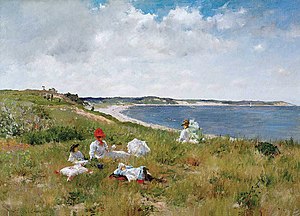| Idle Hours | |
|---|---|
 | |
| Artist | William Merritt Chase |
| Year | 1894 |
| Medium | Oil on canvas |
| Dimensions | 90.2 cm× 64.8 cm(35.5 in× 25.5 in) |
| Location | Amon Carter Museum of American Art, Fort Worth |
Idle Hours is an oil-on-canvas landscape painting by the American Impressionist painter William Merritt Chase. Completed in 1894, it measures 90.2 by 64.8 centimeters, and is now housed at the Amon Carter Museum of American Art, Fort Worth. [1] It is one of many paintings by Chase that depicted his wife and children at ease. [2]